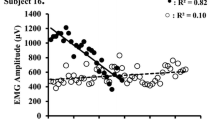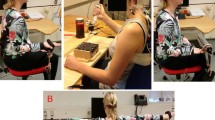Summary
The objective of the present study was to investigate whether isometric contraction of the right triceps brachii muscle, of maximal duration and at 25% of the maximal voluntary contraction (MVC), would reduce mean fibre conduction velocity (CV) for the active motor units (MU). In addition to the cross-correlation of surface electromyograms (EMG) for CV determination, median frequency (f m) and root-mean-square amplitude (rms-amplitude) were calculated. The initial 5 min of the recovery of the three parameters was also investigated. The MVC were performed before and after the sustained contraction. Seven males — six in their twenties and one aged 43 - participated in the investigation. Mean CV for the unfatigued muscle was 4.5 m·s−1, SD 0.38. On average, CV decreased less than 10% during the sustained contraction (P<0.05). Thef m decreased almost linearly (46%) during the endurance time, while three quarters of the 250% increase in rms-amplitude took place during the last 50% of the contraction (P<0.001, both parameters). The MVC was reduced by 39% immediately after exhaustion (P<0.05). During the 1st min of recovery the rms-amplitude decreased by 50%, and the fm increased from 54% to 82% of the initial value (bothP<0.05. No measurable simultaneous CV restitution occurred. A parallel 15% increase inf m and CV took place during the last 4 min of recovery (bothP<0.001), while the amplitude remained constant. Since mean CV was essentially unchanged during the last 50% of the endurance time where large changes inf m and rms-amplitude occurred, factors supplementary to CV probably caused the striking changes in fatigue EMG, notably —MU recruitment, synchronization of MU activity, and lowering of MU firing frequencies. Nevertheless, during the last 4 min of recovery the entire increase inf m could be accounted for by the simultaneous increase in CV.
Similar content being viewed by others
References
Aarås A (1987) Postural load and the development of musculoskeletal illness. Relationship between postural load assessed by EMG and postural angles recordings and the development of musculo-skeletal illness. Scand J Rehabil Med [Suppl] 18:5–35
Andreassen S, Arendt-Nielsen L (1987) Muscle fibre conduction velocity in motor units of the human anterior tibial muscle: a new size principle parameter. J Physiol 391:561–571
Arendt-Nielsen L, Mills KR (1985) The relationship between mean power frequency of the EMG spectrum and muscle fibre conduction velocity. Electroencephalogr Clin Neurophysiol 60:130–134
Arendt-Nielsen L, Mills KR (1988) Muscle fibre conduction velocity, mean power frequency, mean EMG voltage and force during submaximal fatiguing contractions of human quadriceps. Eur J Appl Physiol 58:20–25
Arendt-Nielsen L, Mills KR, Forster A (1989) Changes in muscle fiber conduction velocity, mean power frequency, and mean EMG voltage during prolonged submaximal contractions. Muscle Nerve 12:493–497
Bigland-Ritchie B, Donovan EF, Roussos CS (1981) Conduction velocity and EMG power spectrum changes in fatigue of sustained maximal efforts. J Appl Physiol 51:1300–1305
Blinowska A, Verroust J (1987) Low frequency power spectrum of the EMG signal. Electromyogr Clin Neurophysiol 27:349–353
Blinowska A, Verroust J, Cannet G (1979) The determination of motor units characteristics from the low frequency electromyographic spectra. Electromyogr Clin Neurophysiol 19:281–290
Bonde-Petersen F (1960) Muscle training by static concentric and eccentric contractions. Acta Physiol Scand 48:406–416
Broman H (1977) An investigation on the influence of a sustained contraction on the succession of action potentials from a single motor unit. Electromyogr Clin Neurophysiol 17:341–358
Broman H, Bilotto G, De Luca CJ (1985) Myoelectric signal conduction velocity and spectral parameters: influence of force and time. J Appl Physiol 58:1428–1437
Buchtal F, Madsen A (1950) Synchronous activity in normal and atrophie muscle. Electroencephalogr Clin Neurophysiol 2:425–444
Chaffin DB (1969) Electromyography - a method of measuring local muscle fatigue. J Meth-Time Measurem 14:29–36
Chaffin DB (1973) Localized muscle fatigue - definition and measurement. J Occup Med 15:346–354
Christensen H (1986) Muscle activity and fatigue in the shoulder muscles of assembly-plant employees. Scand J Work Environ Health 12:582–587
Conover WJ (1980) Practical nonparametric statistics, 2nd edn. Wiley, New York, pp 278–309
Darcus HD (1953) A strain-gauge dynamometer for measuring the strength of muscle contraction and for re-educating muscles. Annu Rev Phys Med 1:163–176
De Luca CJ (1985) Myoelectrical manifestations of localized muscular fatigue in humans. CRC Crit Rev Biomed Eng 11:251–279
De Luca CJ, Forrest WJ (1973) Some properties of motor unit action potential trains recorded during constant force isometric contractions in man. Kybernetik 12:160–168
Eberstein A, Beattie B (1985) Simultaneous measurement of muscle conduction velocity and EMG power spectrum changes during fatigue. Muscle Nerve 8:768–773
Fallentin N, Sidenius B, Jørgensen K (1985) Blood pressure, heart rate and EMG in low-level static contractions. Acta Physiol Scand 125:265–275
Gamet D, Maton B (1989) The fatigability of two agonistic muscles in human isometric voluntary submaximal contraction: an EMG study. I. Assessment of muscular fatigue by means of surface EMG. Eur J Appl Physiol 58:361–368
Hagberg M (1981) Muscular endurance and surface electromyogram in isometric and dynamic exercise. J Appl Physiol 51:1–7
Jørgensen K, Fallen N, Sidenius B (1989) The strain on the shoulder and neck muscles during letter sorting. Int J INd Ergon 3:243–248
Kato M, Murakami S, Takahashi K, Hirayama H (1981) Motor unit activities during maintained voluntary muscle contractions at constant levels in man. Neurosci Lett 25:149–154
Kilbom Å, Gamberale F, Persson J, Annwall G (1983) Physiological and psychological indices of fatigue during static contractions. Eur J Appl Physiol 50:179–193
Kogi K, Hakamada T (1962) Frequency analysis of the surface electromyogram in muscle fatigue. J Sci Labour (Tokyo) 38:519–528
Lago P, Jones NB (1977) Effect of motor-unit Eiring time statistics on e.m.g. spectra. Med Biol Eng Comput 15:648–655
Lindström LH, Magnusson RI (1977) Interpretation of myoelectric power spectra: a model and its applications. Proc IEEE 65:653–662
Lindström L, Petersén I (1983) Electromyography in muscle fatigue studies: power spectrum analysis and signal theory aspects. In: Knuttgen HG, Vogel JA, Poortmans J (eds) Biochemistry of exercise, International series on sports sciences, 13. Human Kinetics, Champaign, Ill., pp 187–196
Lindström L, Magnusson R, Petersén I (1970) Muscular fatigue and action potential conduction velocity changes studied with frequency analysis of EMG signals. Electromyography 10:341–356
Lindström L, Kadefors R, Petersén I (1977) An electromyographic index for localized muscle fatigue. J Appl Physiol 43:750–754
Maton B, Gamet D (1989) The fatigability of two agonistic muscles in human isometric voluntary submaximal contraction: an EMG study. II. Motor unit firing rate and recruitment. Eur J Appl Physiol 58:369–374
Mucke R, Zöllner I (1986) Muscle fibre conduction velocity during fatiguing and nonfatiguing isometric arm contractions. Biomed Biochim Acta 45:S77–S80
Naeije M, Zorn H (1982) Relation between EMG power spectrum shifts and muscle fibre action potential conduction velocity changes during local muscular fatigue in man. Eur J Appl Physiol 50:23–33
Naeije M, Zorn H (1983) Estimation of the action potential conduction velocity in human skeletal muscle using the surface EMG cross-correlation technique. Electromyogr Clin Neurophysiol 23:73–80
Nishizono H, Saito Y, Miyashita M (1979) The estimation of conduction velocity in human skeletal muscle in situ with surface electrodes. Electroencephalogr Clin Neurophysiol 46:659–664
Person RS, Kudina LP (1972) Discharge frequency and discharge pattern of human motor units during voluntary contraction of muscle. Electroencephalogr Clin Neurophysiol 32:471–483
Rohmert W (1960) Ermittlung von Erholungspausen für statische Arbeit des Menschen. Int Z Angew Physiol Einschl Arbeitsphysiol 18:123–164
Sadoyama T, Masuda T, Miyano H (1983) Relationships between muscle fibre conduction velocity and frequency parameters of surface EMG during sustained contraction. Eur J Appl Physiol 51:247–256
Sakamoto K, Usui T, Hayami A, Ohkoshi K (1982) The wave analysis with the fast Fourier transform on surface electro myogram and tremor during an acute and an accumulative fatigue. Electromyogr Clin Neurophysiol 22:207–228
Sollie G, Hermens HJ, Boon KL, Wallinga-De Jonge W, Zilvold G (1985a) The boundary conditions for measurement of the conduction velocity of muscle fibres with surface EMG. Electromyogr Clin Neurophysiol 25:45–56
Sollie G, Hermens HJ, Boon KL, Wallinga-De Jonge W, Zilvold G (1985b) The measurement of the conduction velocity of muscle fibres with surface EMG according to the cross-correlation method. Electromyogr Clin Neurophysiol 25:193–204
Stulen FB, De Luca CJ (1978) The relation between the myoelectric signal and physiological properties of constant-force isometric contractions. Electroencephalogr Clin Neurophysiol 45:681–698
Stulen FB, De Luca CJ (1981) Frequency parameters of the myoelectric signal as a measure of muscle conduction velocity. IEEE Trans Biomed Eng BME-28:515–523
Urkowitz H (1983) Signal theory and random processes. Artech House, Dedham, Mass., pp 95–121
Zwarts MJ, Arendt-Nielsen L (1988) The influence of force and circulation on average muscle fibre conduction velocity during local muscle fatigue. Eur J Appl Physiol 58:278–283
Zwarts MJ, Van Weerden TW, Haenen HTM (1987) Relationship between average muscle fibre conduction velocity and EMG power spectra during isometric contraction, recovery and applied ischemia. Eur J Appl Physiol 56:212–216
Author information
Authors and Affiliations
Rights and permissions
About this article
Cite this article
Krogh-Lund, C., Jørgensen, K. Changes in conduction velocity, median frequency, and root mean square-amplitude of the electromyogram during 25% maximal voluntary contraction of the triceps brachii muscle, to limit of endurance. Europ. J. Appl. Physiol. 63, 60–69 (1991). https://doi.org/10.1007/BF00760803
Accepted:
Issue Date:
DOI: https://doi.org/10.1007/BF00760803




